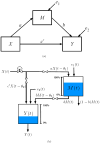Continuous-Time System Identification of a Smoking Cessation Intervention
- PMID: 25382865
- PMCID: PMC4221858
- DOI: 10.1080/00207179.2013.874080
Continuous-Time System Identification of a Smoking Cessation Intervention
Abstract
Cigarette smoking is a major global public health issue and the leading cause of preventable death in the United States. Toward a goal of designing better smoking cessation treatments, system identification techniques are applied to intervention data to describe smoking cessation as a process of behavior change. System identification problems that draw from two modeling paradigms in quantitative psychology (statistical mediation and self-regulation) are considered, consisting of a series of continuous-time estimation problems. A continuous-time dynamic modeling approach is employed to describe the response of craving and smoking rates during a quit attempt, as captured in data from a smoking cessation clinical trial. The use of continuous-time models provide benefits of parsimony, ease of interpretation, and the opportunity to work with uneven or missing data.
Keywords: behavioral science; continuous-time identification; self-regulation; smoking cessation; statistical mediation.
Figures







References
-
- American Cancer Society. Guide to Quitting Smoking. 2012 - PubMed
-
- Bollen K. Wiley Series in Probability and Mathematical Statistics. New York: John Wiley and Sons; 1989. Structural Equations with Latent Variables.
-
- Carver C, Scheier M. On the Self-Regulation of Behavior. New York City, New York: Combridge University Press; 1998.
Grants and funding
LinkOut - more resources
Full Text Sources
Other Literature Sources
